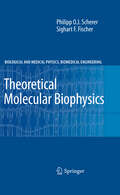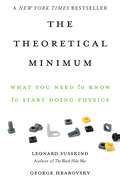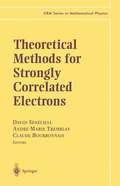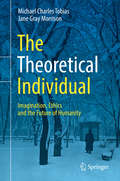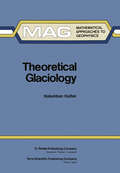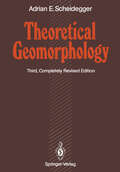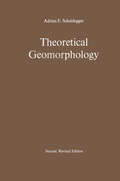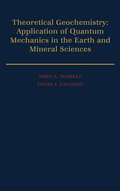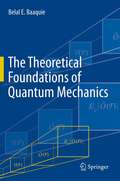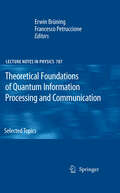- Table View
- List View
Theoretical Physics 2: Analytical Mechanics
by Wolfgang NoltingThis textbook offers a clear and comprehensive introduction to analytical mechanics, one of the core components of undergraduate physics courses. The book starts with a thorough introduction into Lagrangian mechanics, detailing the d’Alembert principle, Hamilton’s principle and conservation laws. It continues with an in-depth explanation of Hamiltonian mechanics, illustrated by canonical and Legendre transformation, the generalization to quantum mechanics through Poisson brackets and all relevant variational principles. Finally, the Hamilton-Jacobi theory and the transition to wave mechanics are presented in detail.Ideally suited to undergraduate students with some grounding in classical mechanics, the book is enhanced throughout with learning features such as boxed inserts and chapter summaries, with key mathematical derivations highlighted to aid understanding. The text is supported by numerous worked examples and end of chapter problem sets. About the Theoretical Physics series Translated from the renowned and highly successful German editions, the eight volumes of this series cover the complete core curriculum of theoretical physics at undergraduate level. Each volume is self-contained and provides all the material necessary for the individual course topic. Numerous problems with detailed solutions support a deeper understanding. Wolfgang Nolting is famous for his refined didactical style and has been referred to as the "German Feynman" in reviews.
Theoretical Physics 1: Classical Mechanics
by Wolfgang NoltingDer Grundkurs Theoretische Physik deckt in sieben Bänden alle für Diplom- und Bachelor/Master-Studiengänge maßgeblichen Gebiete ab. Jeder Band vermittelt das im jeweiligen Semester nötige theoretisch-physikalische Rüstzeug. Übungsaufgaben mit ausführlichen Lösungen dienen der Vertiefung des Stoffs. Band 1 behandelt die klassische Mechanik. Vorausgesetzt wird nur die übliche Schulmathematik, andere mathematische Hilfsmittel werden zu Beginn ausführlich erläutert. Die zweifarbig gestaltete Neuauflage wurde grundlegend überarbeitet und ergänzt.
Theoretical Molecular Biophysics (Biological and Medical Physics, Biomedical Engineering)
by Philipp O.J. Scherer Sighart F. FischerThe Theoretical Minimum: What You Need to Know to Start Doing Physics (The Theoretical Minimum)
by Leonard Susskind George HrabovskyA master teacher presents the ultimate introduction to classical mechanics for people who are serious about learning physics"Beautifully clear explanations of famously 'difficult' things," --Wall Street JournalA Wall Street Journal Best Book of 2013If you ever regretted not taking physics in college--or simply want to know how to think like a physicist--this is the book for you. In this bestselling introduction, physicist Leonard Susskind and hacker-scientist George Hrabovsky offer a first course in physics and associated math for the ardent amateur. Challenging, lucid, and concise, The Theoretical Minimum provides a tool kit for amateur scientists to learn physics at their own pace.
Theoretical Methods in the Physical Sciences: An introduction to problem solving using Maple V
by William E. BaylisThe advent of relatively inexpensive but powerful computers is af fecting practically all aspects of our lives, but some of the greatest influence is being felt in the physical sciences. However, university curricula and teaching methods have responded somewhat cautiously, having only recently come to terms with the now omnipresent calcula tor. While many instructors at first feared that the widespread use of pocket calculators would lead to generations of students who could not multiply or perhaps even add, few now seriously lament the disappear ance of slide rules, logarithm tables, and the often error-bound tedium that such tools of the trade demand. Time that used to be spent on the use of logarithm tables and manual square-root extraction can be prof itably turned to earlier studies of calculus or computer programming. Now that the calculator has been accepted into the classroom, we face a computer-software revolution which promises to be considerably more profound. Modern textbooks in the physical sciences routinely assume their readers have access not only to calculators, but often to home or even mainframe computers as well, and the problems teachers discuss and assign students can be more complex and often more realistic than in the days of only pad and pencil computations. As less effort is spent on numerical computation, more can be devoted to conceptual under standing and to applications of the increasingly sophisticated mathe matical methods needed for a real appreciation of recent advances in the discipline.
Theoretical Methods for Strongly Correlated Electrons (CRM Series in Mathematical Physics)
by David Sénéchal Claude Bourbonnais Ándre-Marie TremblayFocusing on the purely theoretical aspects of strongly correlated electrons, this volume brings together a variety of approaches to models of the Hubbard type - i.e., problems where both localized and delocalized elements are present in low dimensions. The chapters are arranged in three parts. The first part deals with two of the most widely used numerical methods in strongly correlated electrons, the density matrix renormalization group and the quantum Monte Carlo method. The second part covers Lagrangian, Functional Integral, Renormalization Group, Conformal, and Bosonization methods that can be applied to one-dimensional or weakly coupled chains. The third part considers functional derivatives, mean-field, self-consistent methods, slave-bosons, and extensions.
Theoretical Kaleidoscope (Lecture Notes in Physics #747)
by I.B. KhriplovichThis book is based on material taught in general and special theoretical physics courses given by I.B. Khriplovich at the Physics Department of Novosibirsk University, Russia. The book contains the analysis of concrete problems in classical mechanics, classical electrodynamics, quantum mechanics, and relativistic quantum mechanics. To the best of Khriplovich’s knowledge, many of the problems and solutions included in this book have never been discussed in print before.
A Theoretical Introduction to Numerical Analysis
by Victor S. Ryaben'KiiA Theoretical Introduction to Numerical Analysis presents the general methodology and principles of numerical analysis, illustrating these concepts using numerical methods from real analysis, linear algebra, and differential equations. The book focuses on how to efficiently represent mathematical models for computer-based study. An access
A Theoretical Introduction to Numerical Analysis
by Victor S. Ryaben'kii Semyon V. TsynkovA Theoretical Introduction to Numerical Analysis presents the general methodology and principles of numerical analysis, illustrating these concepts using numerical methods from real analysis, linear algebra, and differential equations. The book focuses on how to efficiently represent mathematical models for computer-based study. An access
The Theoretical Individual: Imagination, Ethics and the Future of Humanity
by Michael Charles Tobias Jane Gray MorrisonHow can the one influence the many? From posing seminal questions about what comprises a human individual, to asking whether human evolution is alive and well, favoring individuals or the species, this work is a daring, up-to-the-minute overview of an urgent, multidisciplinary premise. It explores the extent to which human history provides empirical evidence for the capacity of an individual to exert meaningful suasion over their species, and asks: Can an individual influence the survival of the human species and the planet? If there are to be cultures of transformation dedicated to seeing us all through the Sixth Extinction Spasm, the Anthropocene, inflicting as little biological havoc as possible, what might such orientations—a collective, widespread biophilia, or reverence for nature—look like? In this powerful work, with a combination of data and direct observation, the authors invite readers to explore how such transformations might resonate throughout the human community; in what ways a person might overcome the seemingly insurmountable environmental tumult our species has unleashed; the clear and salient motives, ethics, aspirations and pragmatic idealism he/she might mirror and embrace in order to effect a profound difference—at the individual level—for all of life and life’s myriad habitats. Chapters illuminate an ambitiously broad digest of research from two-dozen disciplines. Those include ecodynamics, biosemiotics, neural plasticity, anthropology, paleontology and the history of science, among others. All converge upon a set of ethics-based scenarios for mitigating ecological damage to ourselves and other life forms. This highly readable and tightly woven treatise speaks to scientists, students and all those who are concerned about ethical activism and the future of the biosphere.Michael Charles Tobias and Jane Gray Morrison are ecological philosophers and animal liberation activists who have worked for decades to help enrich our understanding of ecosystem dynamics and humanity’s ambiguous presence amid that great orchestra that is nature.
Theoretical Global Seismology
by F. A. Dahlen Jeroen TrompAfter every major earthquake, the Earth rings like a bell for several days. These free oscillations of the Earth and the related propagating body and surface waves are routinely detected at broad-band seismographic stations around the world. In this book, F. A. Dahlen and Jeroen Tromp present an advanced theoretical treatment of global seismology, describing the normal-mode, body-wave, and surface-wave methods employed in the determination of the Earth's three-dimensional internal structure and the source mechanisms of earthquakes. The authors provide a survey of both the history of global seismological research and the major theoretical and observational advances made in the past decade. The book is divided into three parts. In the first, "Foundations," Dahlen and Tromp give an extensive introduction to continuum mechanics and discuss the representation of seismic sources and the free oscillations of a completely general Earth model. The resulting theory should provide the basis for future scientific discussions of the elastic-gravitational deformation of the Earth. The second part, "The Spherical Earth," is devoted to the free oscillations of a spherically symmetric Earth. In the third part, "The Aspherical Earth," the authors discuss methods of dealing with the Earth's three-dimensional heterogeneity. The book is concerned primarily with the forward problem of global seismology--detailing how synthetic seismograms and spectra may be calculated and interpreted. As a long-needed unification of theories in global seismology, the book will be important to graduate students and to professional seismologists, geodynamicists, and geomagnetists, as well as to astronomers who study the free oscillations of the Sun and other stars.
Theoretical Global Seismology
by F. A. Dahlen Jeroen TrompAfter every major earthquake, the Earth rings like a bell for several days. These free oscillations of the Earth and the related propagating body and surface waves are routinely detected at broad-band seismographic stations around the world. In this book, F. A. Dahlen and Jeroen Tromp present an advanced theoretical treatment of global seismology, describing the normal-mode, body-wave, and surface-wave methods employed in the determination of the Earth's three-dimensional internal structure and the source mechanisms of earthquakes. The authors provide a survey of both the history of global seismological research and the major theoretical and observational advances made in the past decade. The book is divided into three parts. In the first, "Foundations," Dahlen and Tromp give an extensive introduction to continuum mechanics and discuss the representation of seismic sources and the free oscillations of a completely general Earth model. The resulting theory should provide the basis for future scientific discussions of the elastic-gravitational deformation of the Earth. The second part, "The Spherical Earth," is devoted to the free oscillations of a spherically symmetric Earth. In the third part, "The Aspherical Earth," the authors discuss methods of dealing with the Earth's three-dimensional heterogeneity. The book is concerned primarily with the forward problem of global seismology--detailing how synthetic seismograms and spectra may be calculated and interpreted. As a long-needed unification of theories in global seismology, the book will be important to graduate students and to professional seismologists, geodynamicists, and geomagnetists, as well as to astronomers who study the free oscillations of the Sun and other stars.
Theoretical Glaciology: Material Science of Ice and the Mechanics of Glaciers and Ice Sheets (Mathematical Approaches to Geophysics #1)
by K. HutterThe purpose and scope of this book on theoretical glaciology is outlined in the Introduction. Its aim is to study the theoretical aspects of'ice mechanics' and the 'dynamics of ice masses in a geophysical environment. For the mature reader, the book can serve as an introduction to glaciology. How ever, this is not what I would regard as advisible. Glaciology is an inter disciplinary science in which many special scientific disciplines play their part, from descriptive geography to fairly abstract mathematics. Advance ment will evolve from a merger of two or more branches of scientific specialization. In the last 20 years, several researchers in different fields of glaciology have written books emphasizing the aspects of their specialities and I have listed some which are known to me at the end of the Introduction. When glancing through these books, one recognizes that the mathematical aspects of glaciology are generally glossed over and, to date, there seems to be nothing available which concentrates on these. Therefore, I have written this book in an effort to close the gap and no apologies are offered for the mathematical emphasis. Rather, I believe that this neglect has, to a certain extent, aggra vated progress in the modelling of glaciology problems.
Theoretical Geophysical Fluid Dynamics (Environmental Fluid Mechanics #6)
by MoninThis book grew out of lectures on geophysical fluid dynamics delivered over many years at the Moscow Institute of Physics and Technology by the author (and, with regard to some parts of the book, by his colleagues). During these lectures the students were advised to read many books, and sometimes individual articles, in order to acquaint themselves with the necessary material, since there was no single book available which provided a sufficiently complete and systematic account (except, perhaps, the volumes on Hydrophysics of the Ocean, Hydrodynamics of the Ocean, and Geodynamics in the ten-volume Oceanology series published by Nauka Press in 1978-1979; these refer, however, specifically to the ocean, and anyway they are much too massive to be convenient for study by students). As far as we know, no text corresponding to our understanding of geophysical fluid dynamics has as yet been published outside the Soviet Union. The present book is designed to fill this gap. Since it is customary to write the preface after the entire book has been completed, the author has an opportunity there to raise some points of possible criticism by the reviewers and readers. First of all, note that this work presents the theoretical fundamentals of geophysical fluid dynamics, and that observational and experimental data (which in the natural sciences are always very copious) are referred to only rarely and briefly.
Theoretical Geomorphology
by Adrian E. ScheidegerThe surface features of the Earth are commonly split into two cate gories, the first of which comprises those features that are due to processes occurring inside the solid Earth (endogenetic features) and the second those that are due to processes occurring outside the solid Earth (exogenetic features). Specifically, the endogenetic features are treated in the science of geodynamics, the exogenetic features in the science of geomorphology. I have treated the theoretical aspects of the endogenetic features in my "Principles of Geodynamics", and it is my aim to supplement my earlier book with a discussion of the theory of the exogenetic features. It is my hope that the two books will together present a reasonably coherent, if necessarily incomplete, account of theoretical geology. Contrary to endogenetic phenomena, exogenetic processes can often be directly observed as they occur: the action of a river, the development of a slope and the evolution of a shore platform are all sufficiently rapid so that they can be seen as they take place. This has the result that in geomorphology one is generally on much less speculative ground regard ing the mechanics of the processes at work than one is in geodynamics.
Theoretical Geomorphology
by Adrian E. ScheideggerThe surface features of the Earth are commonly split into two categories, the first of which comprises those features that are due to processes occurring inside the solid Earth (endogenic features) and the second those that are due to processes occurring outside the solid Earth (exogenic features). Specifically, the endogenic features are treated in the science of geodynamics, the exogenic features in the science of geomorphology. I have treated the theoretical aspects of the endogenic features in my Principles of Geodynamics, and it is my aim to supplement my earlier book with a discussion of the theory of the exogenic features, the taxonomy of the latter having been discussed in my Systematic Geomorphology. It is my hope that the three books will together pre sent a reasonably coherent, if necessarily incomplete, account of theoretical geology. Contrary to endogenic phenomena, exogenic processes can often be directly observed as they occur: the action of a river, the develop ment of a slope, and the evolution of a shore platform are all suffi ciently rapid so that they can be seen as they take place. This has the result that in geomorphology one is generally on much less specula tive ground regarding the mechanics of the processes at work than one is in geodynamics.
Theoretical Geomorphology
by Adrian E. ScheideggerThe surface features of the Earth are commonly split into two cate gories, the first of which comprises those features that are due to processes occurring inside the solid Earth (endogenetic features) and the second those that are due to processes occurring outside the solid Earth (exogenetic features). Specifically, the endogenetic features are treated in the science of geodynamics, the exogenetic features in the science of geomorphology. I have treated the theoretical aspects of the endogenetic features in my "Principles of Geodynamics", and it is my aim to supplement my earlier book with a discussion of the theory of the exogenetic features. It is my hope that the two books will together present a reasonably coherent, if necessarily incomplete, account of theoretical geology. Contrary to endogenetic phenomena, exogenetic processes can often be directly observed as they occur: the action of a river, the development of a slope and the evolution of a shore platform are all sufficiently rapid so that they can be seen as they take place. This has the result that in geomorphology one is generally on much less speculative ground regard ing the mechanics of the processes at work than one is in geodynamics.
Theoretical Geochemistry: Applications Of Quantum Mechanics In The Earth And Mineral Sciences
by John A. Tossell David J. VaughanTheoretical Frontiers in Black Holes and Cosmology: Theoretical Perspective in High Energy Physics (Springer Proceedings in Physics #176)
by Renata Kallosh Emanuele OraziThese lecture notes are dedicated to the most recent theoretical applications of Black Hole solutions in high-energy physics. The main motivation of this volume is to present the latest black hole backgrounds that are relevant for gauge/gravity correspondence. Leading scientists in the field explain effective techniques for finding singular and cosmological solutions embedded in gauged supergravity, shedding light on underlying properties and symmetries. Starting from a basic level, the mathematical structures underlying black holes and cosmologies are revealed, helping the reader grasp the connection between theoretical approaches and physical observations with insights into possible future developments from both a theoretical and experimental point of view. The topics covered in this volume are based on lectures delivered during the “Theoretical Frontiers in Black Holes and Cosmology” school, held in Natal in June 2015.
The Theoretical Foundations of Quantum Mechanics
by Belal E. BaaquieThe Theoretical Foundations of Quantum Mechanics addresses fundamental issues that are not discussed in most books on quantum mechanics. This book focuses on analyzing the underlying principles of quantum mechanics and explaining the conceptual and theoretical underpinning of quantum mechanics. In particular, the concepts of quantum indeterminacy, quantum measurement and quantum superposition are analyzed to clarify the concepts that are implicit in the formulation of quantum mechanics.The Schrodinger equation is never solved in the book. Rather, the discussion on the fundamentals of quantum mechanics is treated in a rigorous manner based on the mathematics of quantum mechanics. The new concept of the interplay of empirical and trans-empirical constructs in quantum mechanics is introduced to clarify the foundations of quantum mechanics and to explain the counter-intuitive construction of nature in quantum mechanics.The Theoretical Foundations of Quantum Mechanics is aimed at the advanced undergraduate and assumes introductory knowledge of quantum mechanics. Its objective is to provide a solid foundation for the reader to reach a deeper understanding of the principles of quantum mechanics.
Theoretical Foundations of Quantum Information Processing and Communication: Selected Topics (Lecture Notes in Physics #787)
by Erwin Brüning Francesco PetruccioneBased on eight extensive lectures selected from those given at the renowned Chris Engelbrecht Summer School in Theoretical Physics in South Africa, this text on the theoretical foundations of quantum information processing and communication covers an array of topics, including quantum probabilities, open systems, and non-Markovian dynamics and decoherence. It also addresses quantum information and relativity as well as testing quantum mechanics in high energy physics. Because these self-contained lectures discuss topics not typically covered in advanced undergraduate courses, they are ideal for post-graduate students entering this field of research. Some of the lectures are written at a more introductory level while others are presented as tutorials that survey recent developments and results in various subfields.
Theoretical Fluid Dynamics (Theoretical and Mathematical Physics)
by Achim FeldmeierThis textbook gives an introduction to fluid dynamics based on flows for which analytical solutions exist, like individual vortices, vortex streets, vortex sheets, accretions disks, wakes, jets, cavities, shallow water waves, bores, tides, linear and non-linear free-surface waves, capillary waves, internal gravity waves and shocks. Advanced mathematical techniques ("calculus") are introduced and applied to obtain these solutions, mostly from complex function theory (Schwarz-Christoffel theorem and Wiener-Hopf technique), exterior calculus, singularity theory, asymptotic analysis, the theory of linear and nonlinear integral equations and the theory of characteristics.Many of the derivations, so far contained only in research journals, are made available here to a wider public.
Theoretical, Experimental, and Numerical Contributions to the Mechanics of Fluids and Solids: A collection of papers in honor of Paul M. Naghdi
by James Casey Marcel J. CrochetThis special issue of ZAMP is published to honor Paul M. Naghdi for his contributions to mechanics over the last forty years and more. It is offered in celebration of his long, productive career in continuum mechan ics; a career which has been marked by a passion for the intrinsic beauty of the subject, an uncompromising adherence to academic standards, and an untiring devotion to our profession. Originally, this issue was planned in celebration of Naghdi's 70th birthday, which occurred on 29 March 1994. But, as the papers were being prepared for the press, it became evident that the illness from which Professor Naghdi had been suffering during recent months was extremely serious. On 26 May 1994, a reception took place in the Department of Mechanical Engineering at Berkeley, at which Naghdi received The Berkeley Citation (which is given in lieu of an honorary degree) and where he was also presented with the Table of Contents of the present collection. Subse quently, he had the opportunity to read the papers in manuscript form. He was very touched that his colleagues had chosen to honor him with their fine contributions. The knowledge that he was held in such high esteem by his fellow scientists brought a special pleasure and consolation to him in his last weeks. On Saturday evening, 9 July 1994, Paul Naghdi succumbed to the lung cancer which he had so courageously endured.
Theoretical Concepts of X-Ray Nanoscale Analysis: Theory and Applications (Springer Series in Materials Science #183)
by Andrei Benediktovich Ilya Feranchuk Alexander UlyanenkovThis book provides a concise survey of modern theoretical concepts of X-ray materials analysis. The principle features of the book are: basics of X-ray scattering, interaction between X-rays and matter and new theoretical concepts of X-ray scattering. The various X-ray techniques are considered in detail: high-resolution X-ray diffraction, X-ray reflectivity, grazing-incidence small-angle X-ray scattering and X-ray residual stress analysis. All the theoretical methods presented use the unified physical approach. This makes the book especially useful for readers learning and performing data analysis with different techniques. The theory is applicable to studies of bulk materials of all kinds, including single crystals and polycrystals as well as to surface studies under grazing incidence. The book appeals to researchers and graduate students alike.


